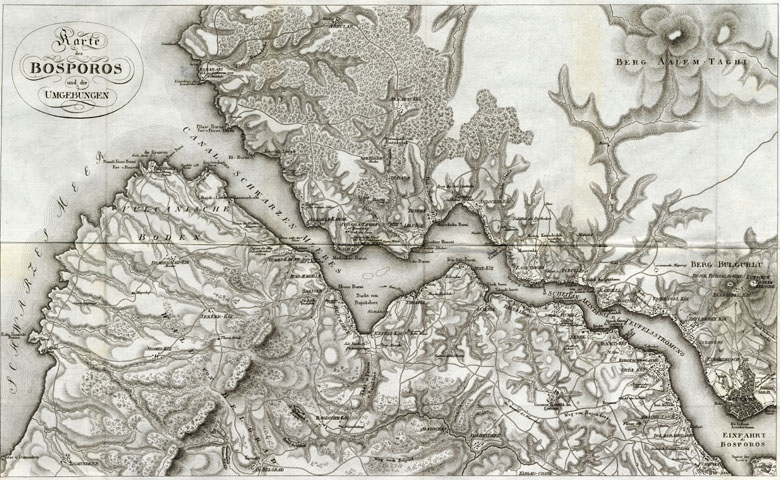



 In 1742,
with the publication of the Persian dictionary of Hasan ªucûrî,
a chapter of Ottoman book printing came to an end. With the death of Müteferrika
the printing of Turkish books was temporarily interrupted.
In 1742,
with the publication of the Persian dictionary of Hasan ªucûrî,
a chapter of Ottoman book printing came to an end. With the death of Müteferrika
the printing of Turkish books was temporarily interrupted.The first generation of Ottoman-Turkish prints was soon followed by a new series, when in 1756 Ahmed and İbrâhîm Efendi (the latter perhaps the founder’s son, according to speculative sources) made an attempt to resurrect the legacy of Müteferrika in the possession of a decree obtained from the Sultan. However, this experiment did not prove to be lasting, because it did not last longer than the new edition of the first Turkish printed book, the Lugat-ı Vankûlî.


After this for several decades there was no continuation to the Turkish book printing established by Müteferrika, until in 1783 the workshop was put in operation again for the publication of six more works. The subjects of these late 18th-century works were dominated by history and military technology, thus Müteferrika’s strategy of book distribution made its way hand in hand with the efforts of modernization of the Ottoman state.
The second edition of Lugat-ı Vankûlî follows the principles of the first edition, and its introduction was composed on the model of the introductory pages of the two last books published under Müteferrika’s supervision. The works published after 1783 show a noticeable development in typography not only as to its somewhat refined visual impression, but also in its structure. For example, the d+h and r+h ligatures, characteristic of the first generation of Müteferrika’s printed books, are replaced by separate letters.
From the seven publications of this late period of the printing house, the
Oriental Collection of the Library of the Hungarian Academy preserves four ones.
 |
[1] Mustafa Mehmed el-Vânî (died 1592): Lugat-i Vankûli, 1170/1756 This work is the Turkish version by Mustafa Mehmed el-Vânî (died 1592) of the medieval Arab dictionary made by Ismācīl ibn Ḥammād al-Ğawharī (died ca. 1003) and known as Mucğam al-Ṣiḥāḥ. It was published in two volumes, the first of which includes the Sultan’s decree permitting the working of the press, this time signed by cOsmân III (1754-1757). The Oriental Collection preserves the second edition of the work,
published in 1756 [MTAK shelfmark:
743.394], from the bequest of Ármin Vámbéry. |
 |
[2] Tevârîh-i Sâmî ve ªâkir ve Subhî, 1198/1784 The publication of Ottoman chronicles which began in 1734 with the edition of Nacimâ’s history, continued after a long break in 1783. This volume, containing the works of three court chroniclers who followed each other in rapid succession, is a chronological continuation of Mehmed Râºid’s history, published by Müteferrika. Arpaemînizâde Mustafa Sâmî (died 1734) was the court’s historian from 1730 to 1733, ªâkir Hüseyin (died 1742) in 1733, and Subhî Mehmed (ca. 1711 – 1769) from 1739 to 1745. The work of the three chroniclers is known as one coherent historiography, which presents the events of Ottoman history from 1730 to 1744. This work is a particularly valuable source on the Hapsburg-Ottoman war between 1736 and 1739, in which Subhî personally participated. The prestige of the work, which offers detailed data on the administrative events (appointments, dismissals and other biographical communications) is further increased by the fact that Subhî in many cases used original documents. The Oriental Collection preserves two copies [MTAK
shelfmark:
768.407; 768.408] |
 |
[3] cİzzî Süleymân: Târîh-i cİzzî,
1199/1784 size: [9], 288 fol.; printed surface: 145×250 mm; page: 205×320 mm; lines: 33. Süleymân cİzzî followed in 1745 Mehmed Subhî Efendi as an official court historian (vakacnüvis), and held this office until 1753. During this time he registered the contemporary events of the Ottoman Empire. This work was the last item in the series of chronicles published by the printing house founded by Müteferrika. One copy can be found in the Oriental Collection [MTAK
shelfmark: 768.405]. |
 |
[4] Zaynîzâde, Hüseyin ibn Ahmed: İcrâb ül-Kâfiye,
1200/1785 This work, a commentary to Ibn al-Ḥāğib’s (1175-1249) grammar al-Kāfiya fī l-naḥw, was the only Arabic grammatical work in the second series of the Turkish press. The only copy in the Oriental Collection is a donation by Gábor Korvin [MTAK jelzet: 773.106].
|

Detail of Joseph von Hammer Purgstall’s (1774-1856) Map of the Bosporus, from his work Constantinopolis und der Bosporos (1822), preserved in the Oriental Collection of the LHAS (701.298)